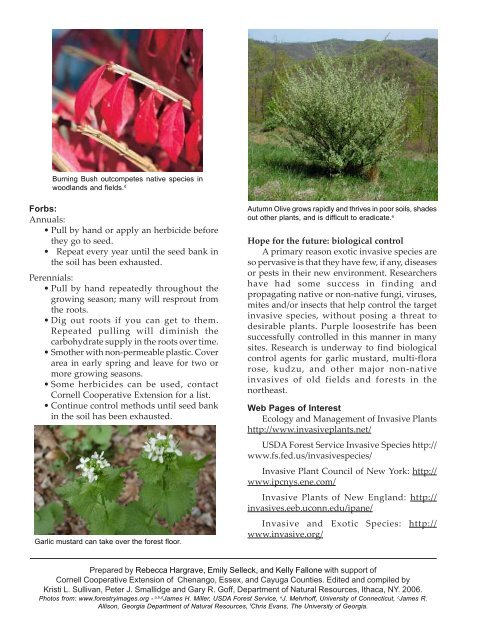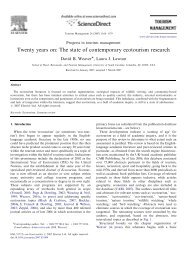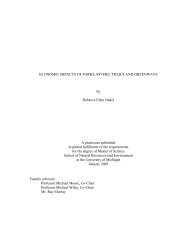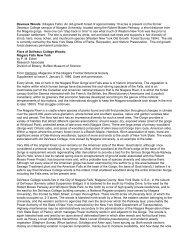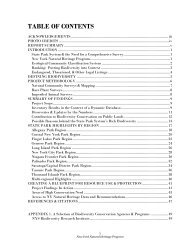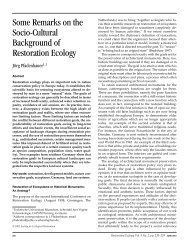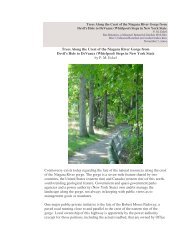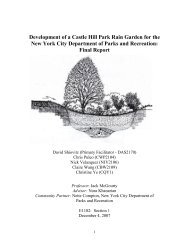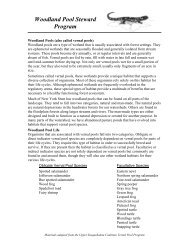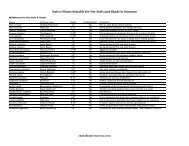Controlling Invasive Species in Woodlots - Wild Ones Niagara
Controlling Invasive Species in Woodlots - Wild Ones Niagara
Controlling Invasive Species in Woodlots - Wild Ones Niagara
Create successful ePaper yourself
Turn your PDF publications into a flip-book with our unique Google optimized e-Paper software.
Burn<strong>in</strong>g Bush outcompetes native species <strong>in</strong><br />
woodlands and fields. d<br />
Forbs:<br />
Annuals:<br />
• Pull by hand or apply an herbicide before<br />
they go to seed.<br />
• Repeat every year until the seed bank <strong>in</strong><br />
the soil has been exhausted.<br />
Perennials:<br />
• Pull by hand repeatedly throughout the<br />
grow<strong>in</strong>g season; many will resprout from<br />
the roots.<br />
• Dig out roots if you can get to them.<br />
Repeated pull<strong>in</strong>g will dim<strong>in</strong>ish the<br />
carbohydrate supply <strong>in</strong> the roots over time.<br />
• Smother with non-permeable plastic. Cover<br />
area <strong>in</strong> early spr<strong>in</strong>g and leave for two or<br />
more grow<strong>in</strong>g seasons.<br />
• Some herbicides can be used, contact<br />
Cornell Cooperative Extension for a list.<br />
• Cont<strong>in</strong>ue control methods until seed bank<br />
<strong>in</strong> the soil has been exhausted.<br />
Garlic mustard can take over the forest floor.<br />
Autumn Olive grows rapidly and thrives <strong>in</strong> poor soils, shades<br />
out other plants, and is difficult to eradicate. e<br />
Hope for the future: biological control<br />
A primary reason exotic <strong>in</strong>vasive species are<br />
so pervasive is that they have few, if any, diseases<br />
or pests <strong>in</strong> their new environment. Researchers<br />
have had some success <strong>in</strong> f<strong>in</strong>d<strong>in</strong>g and<br />
propagat<strong>in</strong>g native or non-native fungi, viruses,<br />
mites and/or <strong>in</strong>sects that help control the target<br />
<strong>in</strong>vasive species, without pos<strong>in</strong>g a threat to<br />
desirable plants. Purple loosestrife has been<br />
successfully controlled <strong>in</strong> this manner <strong>in</strong> many<br />
sites. Research is underway to f<strong>in</strong>d biological<br />
control agents for garlic mustard, multi-flora<br />
rose, kudzu, and other major non-native<br />
<strong>in</strong>vasives of old fields and forests <strong>in</strong> the<br />
northeast.<br />
Web Pages of Interest<br />
Ecology and Management of <strong>Invasive</strong> Plants<br />
http://www.<strong>in</strong>vasiveplants.net/<br />
USDA Forest Service <strong>Invasive</strong> <strong>Species</strong> http://<br />
www.fs.fed.us/<strong>in</strong>vasivespecies/<br />
<strong>Invasive</strong> Plant Council of New York: http://<br />
www.ipcnys.ene.com/<br />
<strong>Invasive</strong> Plants of New England: http://<br />
<strong>in</strong>vasives.eeb.uconn.edu/ipane/<br />
<strong>Invasive</strong> and Exotic <strong>Species</strong>: http://<br />
www.<strong>in</strong>vasive.org/<br />
Prepared by Rebecca Hargrave, Emily Selleck, and Kelly Fallone with support of<br />
Cornell Cooperative Extension of Chenango, Essex, and Cayuga Counties. Edited and compiled by<br />
Kristi L. Sullivan, Peter J. Smallidge and Gary R. Goff, Department of Natural Resources, Ithaca, NY. 2006.<br />
Photos from: www.forestryimages.org - a,b,d James H. Miller, USDA Forest Service, e J. Mehrhoff, University of Connecticut, c James R.<br />
Allison, Georgia Department of Natural Resources, f Chris Evans, The University of Georgia.


